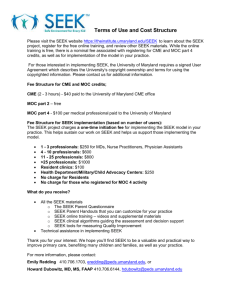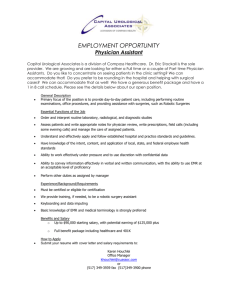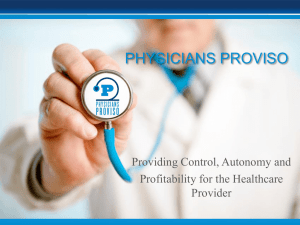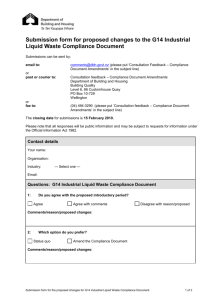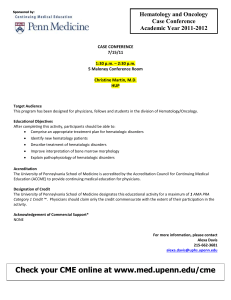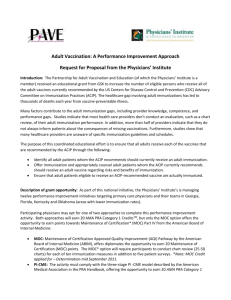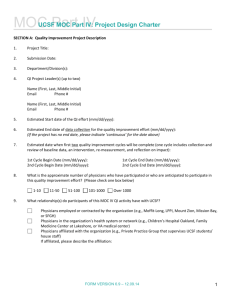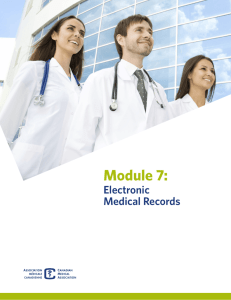Hot Spots thoughts Reizner
advertisement
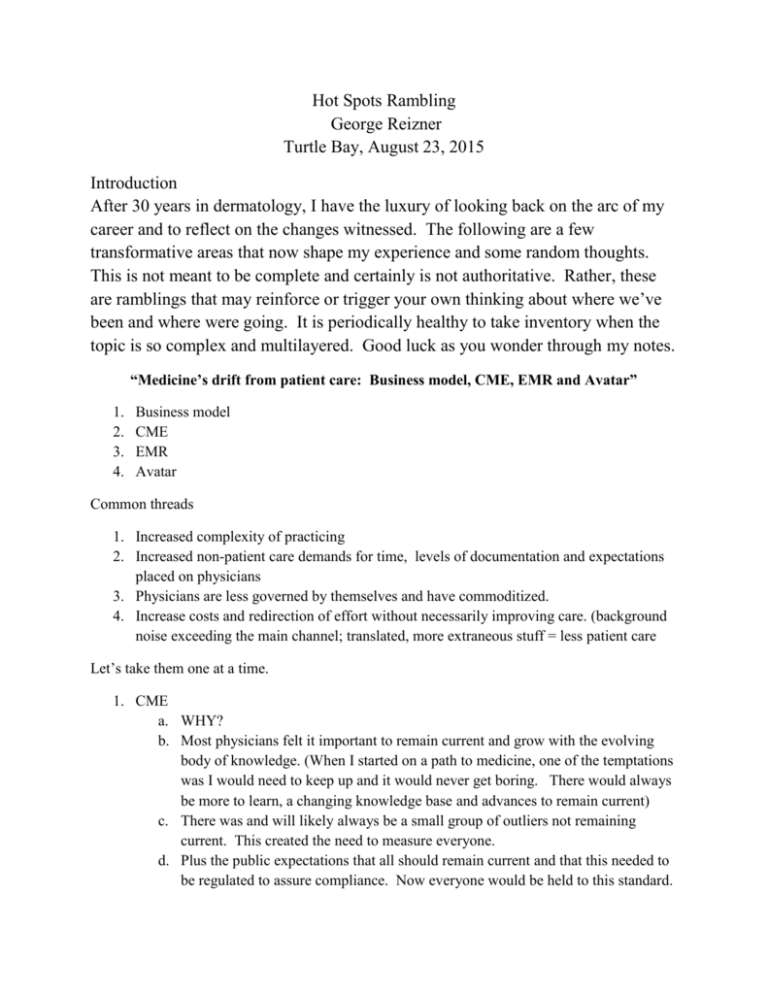
Hot Spots Rambling George Reizner Turtle Bay, August 23, 2015 Introduction After 30 years in dermatology, I have the luxury of looking back on the arc of my career and to reflect on the changes witnessed. The following are a few transformative areas that now shape my experience and some random thoughts. This is not meant to be complete and certainly is not authoritative. Rather, these are ramblings that may reinforce or trigger your own thinking about where we’ve been and where were going. It is periodically healthy to take inventory when the topic is so complex and multilayered. Good luck as you wonder through my notes. “Medicine’s drift from patient care: Business model, CME, EMR and Avatar” 1. 2. 3. 4. Business model CME EMR Avatar Common threads 1. Increased complexity of practicing 2. Increased non-patient care demands for time, levels of documentation and expectations placed on physicians 3. Physicians are less governed by themselves and have commoditized. 4. Increase costs and redirection of effort without necessarily improving care. (background noise exceeding the main channel; translated, more extraneous stuff = less patient care Let’s take them one at a time. 1. CME a. WHY? b. Most physicians felt it important to remain current and grow with the evolving body of knowledge. (When I started on a path to medicine, one of the temptations was I would need to keep up and it would never get boring. There would always be more to learn, a changing knowledge base and advances to remain current) c. There was and will likely always be a small group of outliers not remaining current. This created the need to measure everyone. d. Plus the public expectations that all should remain current and that this needed to be regulated to assure compliance. Now everyone would be held to this standard. e. It was more to catch those that didn’t remain current. It demanded a threshold of uniformity, but it also forced and regulated our learning. f. Some educators seized on the opportunity to gain influence? Or at least formalize and measure the process. g. Regardless, a new industry was born that offers, regulates and records CME. h. It began modestly with a noble core, but now is its own life force. i. The ways of fulfilling and measuring CME has become more sophisticated, costly and time consuming j. Some pockets of resistance, e.g. Hot Spots k. Are we better? Well, yes and no. 2. EMR a. Oy!!! Where do I start? It’s both good and bad. b. EPIC, one of the largest vendors, is from the Madison area. So we were early adopters of the next generation of EMR and a beta site for rolling out software. c. Good i. Writing and tracking medications, current and past drugs, doses, time table of use and avoiding or at least decreasing the risk of adverse or cross reactions ii. Retrieval of information (if put in the correct place) iii. Review information from other medical centers if linked on EPIC iv. Portable, able to check remotely with internet access v. Possible via app on phones d. Bad i. Time, time, time (not the Simon and Garfunkel song) ii. Cost to acquire and maintain iii. At the mercy of your electrical grid and power failure iv. Cost in terms of time spent to understand and learn, plus updates v. Copy and paste errors and use of templates vi. Need to hunt for the meaningful information in massive notes, i.e. it is easy to populate the note with additional information with a few key strokes and not all is relevant. vii. Time for documentation. Correctly and accurately recording some dermatology encounters takes longer than the patient face to face time. viii. Facing the computer and not the patient. ix. The EMR is written by software developers and not always with physicians and their varied workflow for different specialties or personal styles of practice. Sometime need to think like a software developer. Certainly not written for dermatology. x. Time spent trying to figure out why there is a “hard stop” and to satisfy the EMR. xi. Hard enough if you are can do qwery touch typing and almost insurmountable if you are a “hunt and peck” typer. xii. Management of images is cumbersome and quality of pictures remains limited to the quality of the camera that took it, skill of the picture taker and resolution of the monitor. We use images more for anatomical location of a lesion and less for tracking or diagnosing skin conditions. e. Are we better off? Well yes and no, but there’s also the realization that it is not going away. f. Hope that future generations of EMR’s will solve some of the above limitations or frustrations. 3. Avatar, Press Ganey and other patient satisfaction tools. The rating of physicians based on patient surveys. a. Often taken as an accurate reflection of reality (gospel) while the “n” is small or not statistically significant b. Asks about parking, friendliness of the reception, whether you would refer a friend or family member, many intangibles related to the patient’s experience, but not about treatment outcomes or overall medical care, i.e. these are relatively superficial topics with only some being truly patient care and outcomes. c. Some results can be revealing, but others are unsupported or down right off i. The grumpy doctor can’t hid from his/her lack of interpersonal skills and is quantified ii. It does empower patients by asking for their input iii. Continuity Clinic is run by residents, yet the survey measures the patient’s impression of the attending faculty. But it’s a clinic run by the resident with teaching overview by the faculty (ACGME requirement). But results are not adjusted for this. iv. Explaining a patient’s lab results. There are different levels of understanding and interest by the patient. d. And yet administrators and patients make judgments based on these results. i. The progression of transparency: Initially results just went to the physician, then to the department, then the medical center and finally they will be open to the public. ii. Physician compensation will also be tied to this in the future. iii. There will be some good, but it also redirects energy and attention to matters which detract from the central goals of the visit. e. Can lead to patient interactions that are tailored to maximizing scores, e.g. “Do you have additional input?” The key word is “input” because it is verbatim from the survey. f. Can medicine be rated the same as services such as Angies list or Craig list? g. Are we better? Yes, but mostly no. h. Most believe there should be a re-thinking of what can and should be asked and the medical significance or realistic expectations of what can be learned and what it should be used for. 5. Business model, this deserves an entire day to tease out the key points. a. Medicine has become more business and less art (Elpern) b. Growing complexity of practice requirements made it important to farm out these tasks. c. It started a cycle of more complexity and layers of administration which needed more new infrastructure beyond patient care. Resulting in greater cost, but uncertain whether it improved patient care or outcomes. d. Now medicine is being codified and businessified. Money has become the measure and less patient needs. Sadly money has crept into nearly every corner of medical practice. e. HMO’s, PPO’s, enlarging health alliances (UW voted to join UWHC with UWMF) f. Doctors become more removed from decision making about care delivery. g. Are we better? Yes, but mostly no h. How do we teach our students to be compassionate if the patients are looked at as costing money to the system? 6. MOC (extra credit topic) a. I’m “life time” boarded by the ABD. b. It’s another story about the outliers that took on a life of its own. c. Expectations by the “public” (think 80 hour work week limit for trainees) d. What is MOC really measuring? e. What is it meant to measure? f. Redirects time and effort to just satisfying requirements. g. Current backlash at the level of the AAD. h. Birth of another board which doesn’t require MOC? How will this divide and diminish the specialty as a whole? i. Are we better? The jury is still out. Additional thoughts. What is the meaning of the words “Health Care Provider” or “Provider” vs. saying “My doctor”. 1. 2. 3. 4. 5. 6. Generic versus personal care. Institutional and impersonal instead of the “Family doctor”. Barometer of depersonalization. Blurs the line between NP, PA, nurses, LPN, MA, etc. Suggestion of interchangeable “providers”. Does it also touch on physician mobility, i.e. are doctor less likely to stay in one place for a career? 7. These are not bad words, rather it parallels and reflects some of the changes above and the new world we practice in. It seems to encapsulate the move toward a business model and the depersonalization of health care delivery. Results 1. More mouths to feed in the health care arena. a. Old model of a receptionist, nurse and doctor (sometimes with a nurse/receptionist) b. Increased number of people on the clinical and administrative side between the patient and the doctor c. Bourgeoning levels of administrators d. Coders e. Policy makers f. Formulary police g. Managers of CME, patient satisfaction, MOC h. Mandated on-line courses i. Yada, yada, yada 2. Greed a. All players are at risk of thinking it’s okay and should make as much as possible before the rules change i. Doctors ii. Pharma iii. Hospitals iv. HMO’s, PPO’s, traditional insurance companies, etc. b. Post residency debt i. Education loans ii. Just finished training and need to move, take the boards, replace the old car, buy a house, the second child is on the way, start saving for retirement, college, braces, weddings, bar mitzvahs, etc. iii. Go for the highest paying job where your spouse is willing to live. c. Less likely to be an independent practitioner so from the beginning, you are likely to report to others. d. Risk of maximizing coding and temptation for some to cross over towards fraud. e. Plus the motives of big Pharma, hospitals, makers of durable products, etc. to show profit to shareholders. 3. Are we better off? Health delivery costs more with questioned improved outcomes. 4. If medicine wasn’t about money, we likely wouldn’t be on our current path Entire topics not covered 1. 2. 3. 4. 5. 6. Physician burnout Loss of idealism Changing political landscape Effects of lobbyists Intended and unintended outcomes of the Affordable Care Act. Others Ideas 1. Not new, but worth revisiting. a. Government pays medical education for a certain percentage of medical students in a way it already pays for residencies. b. Require year for year payback in underserved or targeted areas. c. This creates a filter that better helps select for those willing to be committed to taking care of patients. d. Removes the debt burden. e. Provides for health care in needed areas where some physicians might “stick”. f. Could make many of these positions slotted for primary care. g. Reverses a trend towards medical education only for the elite that can afford it. 2. MOC a. Grass roots backlash. b. Creation of an alternative board to the ABD. c. Be careful about the motives. i. Truly to relieve an unjustified burden. ii. Protecting those that wouldn’t academically satisfy the spirit of MOC. 3. CME and EMR a. Probably here to stay. b. CME is entrenched; we should work to improve what it measures. c. EMR, hoping future software generations are more physician and patient friendly. 4. Business model a. The train is gaining more speed. b. Work to remain patient centered. c. Find physician leaders that can straddle patient care and business. d. Select for those interested in the “art” and less the “business”.

